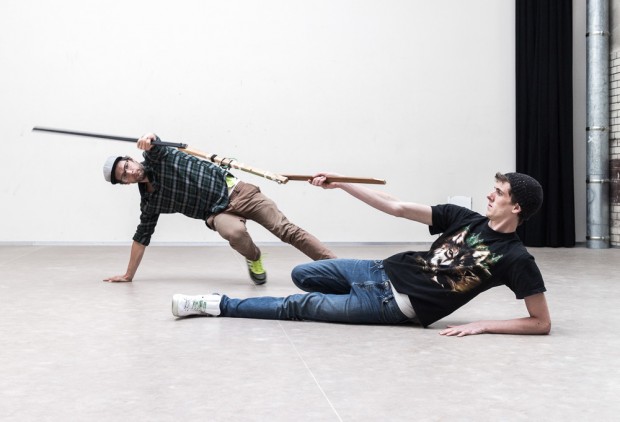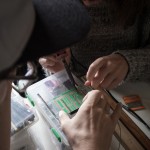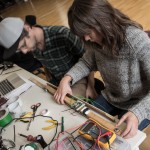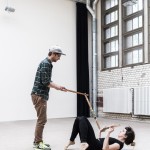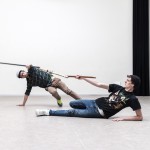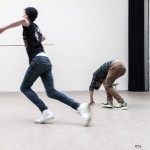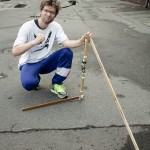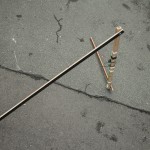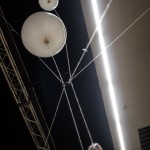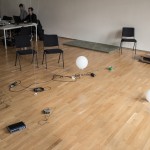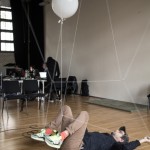In September 2014, Amelie Hinrichsen and Till Bovermann took part in the Choreographic Coding Lab, organised by Jeanne Vogt, Florian Jennet and Scott deLahunta. During the week-long workshop, they worked with dancers/choreographers Joshua Rutter, Lea Pischke and Oliver Connew, trying to find their approach to combine the diverse fields of choreography, programming, dance and sound.
The two studies, Mitbewohner and Best dream ever, are their (first) outcomes, condensed from intense discussions on the respective fields and their relation to each other.
Mitbewohner – flatmate
Three wooden sticks connected to a sculptural kinetic object. An experiment about collaboration, imitation and signification. A sound engine is influenced according to continuous measurements of the angles between the sticks as well as by an accelerometer attached to the middle stick. This study was also performed at retune festival.
Reflections
- The stick was regarded as a „dance partner“ meaning „another body one could relate to“. It was considered to be an „object and space at the same time“.
- „It is interesting for its multidimensionality and multimediality.“
- „It is establishing a link between the analog and the digital, between sound and body.“
- „For its cultic appearance it carries significance in many directions. It is a link into a hidden world.“
- „The structure and quality of the stick was inspiring.“ Also „putting it into certain shapes was interesting“. The quality of movement was regarded as „architectural“.
- Since the mapping of the sound was not „so obvious“ it was „rather an object to dance with, than an object to make sound with.“
Best dream ever
This is the second approach on working with an architectural structure in space, in which we tried to introduce a quality of movement contrasting to Mitbewohner. Six strings connected through three metal rings create a network of wool. Three of the threads are connected to helium-filled balloons, the others hang from the ceiling and have a weight on their dangling end. The dancer connects hands and feet to the structure. Movement of her body induces movement to the system; creating a dream-like imitation and adaptation of the body movements. The vibrations of the threads are amplified, altered by vowel-tuned filters, and finally diffused into the architectural object. An FM feedback network complements the breezy athmosphere of the almost architectural space.
Reflections
- The sound („breezy, light, windy“), the position of the body („lying on the ground“), the perspective („looking up, seeing the floating balloons“) produced a „feeling of peacefulness“.
- The quality of movement was regarded as „liquid“ and „messy“.In contrast to interacting with another structure (as in Mitbewohner), the dancers reported that they found themselves being „implicated in a larger structure“
- When observing a performance with a sound generating object and compare it with playing an instrument, „the scale makes a big difference“.
In general it was mentioned that „having an object, made it less awkward“ to interact and control sonic elements (i.e. integrate technology into dance practice).
Thanks
We’d like to thank Jeanne Vogt, Florian Jennet and Scott deLahunta from the Choreographic Coding Lab (as well as Motion Bank). The combination of SuperCollider, X-OSC, and the Influx system by Alberto de Campo for the prototyping process made the programming a breeze.

